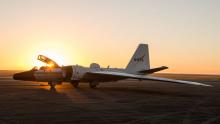Listen to today's episode of StarDate on the web the same day it airs in high-quality streaming audio without any extra ads or announcements. Choose a $8 one-month pass, or listen every day for a year for just $30.
You are here
Eclipse Flights
Navy pilots took to the air 100 years ago today to view one of nature’s most amazing sights: a total solar eclipse. It was the first time that airplanes had been used to study an eclipse. In fact, it was the first attempt at airborne astronomy — studying the universe from above as much of the atmosphere as possible.
Most of the eclipse path was over the Pacific Ocean. But it clipped some islands in southwestern California, then continued across northern Mexico.
Astronomers from around the world set up bases to watch the eclipse — projects that involved years of preparation, dozens of people, and massive logistics efforts. But when the eclipse rolled around, most of them were stymied by clouds.
The U.S. Navy sent up 16 airplanes to watch the eclipse — biplanes with open cockpits. Their main goal was to plot the centerline of the eclipse. That would help astronomers refine their calculations of the Moon’s orbit. A second goal was to snap pictures of the Sun’s corona — its hot, thin outer atmosphere.
Pilots flew at altitudes of one to three miles, across California, Mexico, and the Pacific. They made important observations of the shadow, but none of their pictures worked out — the film was too slow, the airplanes too jittery, the skies too cloudy. But more successful eclipse flights would follow in the coming decades — watching cosmic spectacles from on high.
Script by Damond Benningfield





